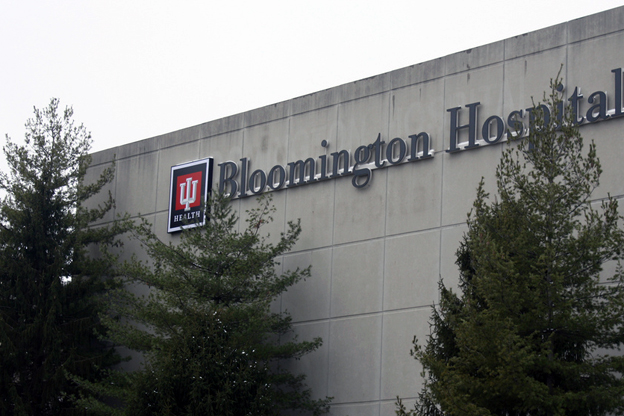
The IU Health Bloomington Hospital. (WFIU/WTIU News)
It’s understandable that people might think Indiana University owns IU Health. But in fact, IU does not own the health care system.
So who does? One listener asked our City Limits: Bloomington reporting project to find out.
“Well actually, no one owns IU Health,” said Kevin Armstrong, executive vice president for mission and values and chief of staff for IU Health. “We’re a not-for-profit organization which means no individual or no group owns that organization.”
Instead, a board of directors oversees the health care system. The structure is more similar to other large nonprofit organizations than to for-profit outfits such as Ford Motor Company or Microsoft.
Because of its nonprofit status, no individual or organization can pocket profits from IU Health. Nonprofit Navigator, a business designed to guide formation of nonprofits, says any profits earned by a nonprofit must be reinvested in capital or programs within the organization or distributed as grants to other 501(c)(3) exempt organizations.
Armstrong says IU Health reinvests heavily in research, education, facilities and capital, and funds projects in communities it serves.
The health care system was launched in 1997. That’s when then IU President Myles Brand announced the formation of Clarian Health, which merged Indianapolis-based Methodist Hospital, Indiana University Hospital and Riley Hospital for Children into one organization.
The system would be governed by a board of directors with only two legal members, the United Methodist Church of Indiana and Indiana University. Those two legal members control the appointment of 14 individual board members.
Current board members include IU President Michael McRobbie, IU board of trustees member Harry Gonso, and IU School of Medicine Dean Jay Hess.
The name was changed to IU Health in 2011 to raise more awareness around Indiana.
“Clarian was a name that didn’t give the kind of identity that we wanted around the state and to be able to have a closer identity with our state and the partnership was important,” Armstrong said.
University spokesman Chuck Carney said the affiliation ties IU to its commitment to the state.
“It sort of helps us promote the brand of Indiana University writ large and what our mission is, which is to serve the state,” he said. “It really speaks to the mission of IU and that was one of the main driving points of putting IU’s name on it.”
Since the name change, IU Health has brought numerous community hospitals into its system and now operates 16 in various sizes. One of them is IU Health Bloomington Hospital, which became part of the system in 2010.
Within the next two years, IU Health Bloomington is scheduled to move from its location on West Second Street to the IU Regional Academic Health Center campus under construction on the Indiana 45/46 Bypass.

IU Health also has bought up many physician practices around the state. Many of the hospitals serve as training grounds for more than 1,000 medical residents and fellows each year. A formal agreement links IU Health and the Indiana University School of Medicine.
“It confirms that the IU School of Medicine and faculty positions provide care in IU Health hospitals and clinics,” Carney said. "And it provides that IU Health will host the educational and research missions of the IU School of Medicine learners in its health care facilities.”
No money changed hands when the IU name replaced Clarian, Carney said. Use of the IU name is governed by a standard licensing agreement with the university.
Massive amounts of money go into and out of IU Health, which reported revenue of $6.43 billion for 2018 and expenses of $5.82 billion. The organization has more than 30,000 employees overall.
IU Health gives hundreds of millions of dollars back to local communities. IU Health’s Armstrong is particularly proud of that.
“One of the things that makes us unique as a health system around the country is the community benefit dollars we invest back into Indiana,” he said.
The total was $561 million in 2017 for health needs such as fighting opioid addiction, infant mortality, smoking and obesity.
No doubt IU Health has grown into a huge entity.
But is bigger always better?
Seth Freedman specializes in health economics and health policy at IU’s O’Neill School of Public and Environmental Affairs. He says large health systems offer benefits and drawbacks.
“There are a number of potential benefits and at the top of people’s minds is coordination,” he said. “So if doctors and hospitals are more integrated into a single system, then they can potentially communicate better, have more integrated electronic health records systems, have less repeated testing, more convenient referrals and those kinds of things.”
He says the negatives come down to the general ideas of competition.
Huge systems can negotiate higher prices with insurance companies, charge higher prices to patients who are paying out of pocket and may let quality slip.
“Because if you’re the only game in town,” he said, “you don’t necessarily have to improve quality to make sure patients keep coming through your doors.”
He added: “The topline potential benefits and costs are it might be smoother and more coordinated, but it might cost more and prices might be higher, and it might lead to incentives to provide lower quality.”
What Indiana is seeing with IU Health is not a unique strategy. Freedman says both the growth of university health systems and the trend of hospitals buying physician practices are common nationally. He says research shows such consolidations have made health care slightly more expensive overall, but he said it’s hard to draw conclusions about quality derived from these changes based on the research that’s been completed so far.
Armstrong says the size of IU Health isn’t the point.
“I think it has less to do with the size than it has to do with the services that can be provided at scale,” he said. “It’s why we have medical schools located around the state and not just in one location. It’s why we have hospitals and our health systems located around the state and not just in one place. The care you get in Bloomington or Paoli or Bedford is the same care we want to deliver in Monticello or Lafayette or Tipton.”
He said although they’re not technically owners, IU and the United Methodist Church have a common goal.
“Recognition that both of us share a mission of improving health and it comes out of our DNA,” he said. “For the university it’s about research and education, and for the United Methodist Church it’s about affordable care and care for those who can’t afford.
“That’s who we are as a church and a university and we’re extending that mission throughout the state.”
Correction: This story has been updated to reflect that IU Health operates 16 hospitals, not 18. Two of their locations are not classified as hospitals.
Have a question? Ask City Limits:
Our community is changing, from closing businesses to traffic and road construction to affordable housing, and we see the impact of these changes all around us.
We want to know: What questions do you have about how the Bloomington of tomorrow will impact your work, your personal life, your community and your future?
Here’s how it works: You submit a question you’d like us to explore about how Bloomington has changed over the past few decades, what you want to see for the city in the future and how ties with IU continue to shape the community.
So: What do you wonder about how Bloomington is changing and how it impacts your life?
Interested in an ongoing conversation how Bloomington is changing? Join our Facebook group!










